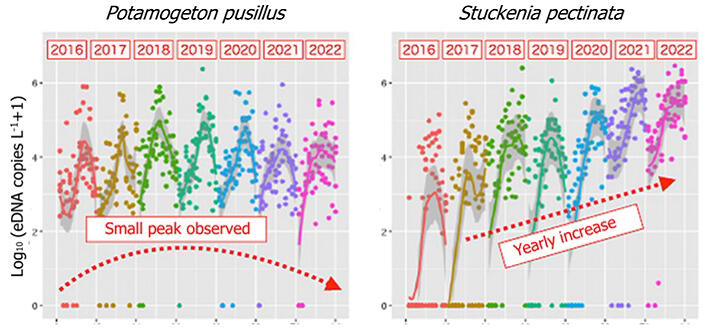A joint research team from Shimane University's Faculty of Life and Environmental Sciences led by Professor Teruhiko Takahara, along with Professor Hideyuki Doi from Kyoto University's Graduate School of Informatics and Professor Toshifumi Minamoto from Kobe University's Graduate School of Human Development and Environment, conducted monitoring using environmental DNA (eDNA) concentration to estimate biomass, focusing on two submerged plant species (aquatic plants) that have been problematically proliferating in Lake Shinji, Shimane Prefecture in recent years. The team announced their successful discovery of annual and seasonal variations of the two species, in addition to the finding that salinity fluctuations in the lake strongly influence which species becomes dominant. These findings suggest promising applications for expanded long-term eDNA monitoring. The team's results were published in the international academic journal Estuarine, Coastal and Shelf Science on January 30.

Provided by Shimane University
Lakes and lagoons support various ecosystem services, with aquatic plants serving as a foundation for these systems. Lake Shinji is a brackish lake where freshwater and seawater mix. Submerged plants such as Potamogeton pusillus and Stuckenia pectinata have been proliferating in large quantities, causing problems including unpleasant odors after they die off. P. pusillus has very low salt tolerance, while S. pectinata has relatively high salt tolerance.
Continuous monitoring is necessary to understand the causes of this excessive growth. However, traditional visual and collection-based biological surveys are costly, and by the time plants are visible from the water surface, it may be too late for countermeasures. eDNA analysis can reveal the presence or absence of specific organisms and estimate their biomass through concentration analysis by simply collecting an approximately one-liter water sample and analyzing the DNA information it contains.
The research group verified whether long-term eDNA monitoring could identify conditions for proliferation and provide early detection to help manage and control the excessive growth of submerged plants in Lake Shinji. They analyzed samples collected from six coastal locations in Lake Shinji over seven years, from January 2016 to December 2022, focusing on P. pusillus and S. pectinata.
The results revealed annual and seasonal variations in the biomass of both species. The eDNA concentration of P. pusillus peaked in 2018 and showed a declining trend thereafter. In contrast, the eDNA concentration of S. pectinata increased year by year. These trends were consistent with biomass observations of the two species conducted by Shimane Prefecture.
Statistical analysis confirmed a negative correlation between P. pusillus eDNA concentration and salinity, while no correlation was found for S. pectinata. The increasing trend in salinity in Lake Shinji in recent years is thought to be a factor in the shift in dominant species from P. pusillus to S. pectinata.
The study showed that eDNA from both species could be detected even in winter when their growth is not visible from the water surface, suggesting its potential use as an indicator for implementing countermeasures before widespread proliferation occurs.
Takahara commented: "Environmental DNA surveys at Lake Shinji began in December 2015, and we have been steadily working with lab students while looking forward to long-term observation results. I feel deeply moved that these efforts have borne fruit and can now be published as a paper. The strength of environmental DNA is that different species can be examined using the same samples. Currently, we are advancing new research to contribute to the sustainable use of important fishery resources in Lake Shinji, such as freshwater clams and eels."
Journal Information
Publication: Estuarine, Coastal and Shelf Science
Title: Seven-year changes in eDNA concentrations of two dominant submerged macrophytes in Lake Shinji: Effects of salinity
DOI: 10.1016/j.ecss.2025.109165
This article has been translated by JST with permission from The Science News Ltd. (https://sci-news.co.jp/). Unauthorized reproduction of the article and photographs is prohibited.




